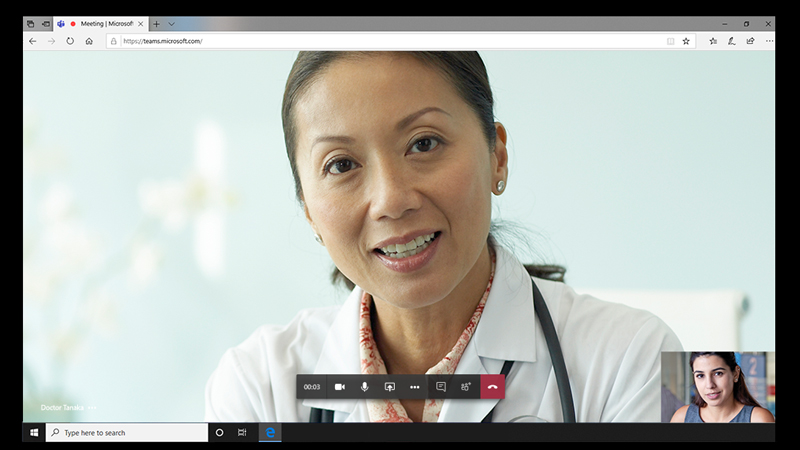
Empowering Canadian healthcare teams with new remote working tools

Like so many Canadians, we’re overwhelmed by the courage and commitment of firstline workers, especially healthcare teams, across the country who put themselves at risk to support us all. We salute and thank you for your service!
The fourth in our Keep your business moving securely series, this blog post summarizes the Microsoft technologies and services healthcare providers can use to adapt to these challenging times.
Working in a complex, regulated care environment—made even more complex by current challenges—healthcare professionals need access to tools that enable collaborative workflows and the delivery of high-quality patient care. Both patients and clinicians need greater flexibility and convenience to connect with each other. And they need it all to be secure, reliable, and compliant.
Let’s explore how Microsoft solutions can support and empower healthcare teams to provide high-quality experiences, insights, and care—without compromising your security or your patients’ privacy.
Need support? Microsoft and our partners can help. Customers can contact their Microsoft rep or email us. You can also work with Microsoft partners specializing in healthcare, such as Dapasoft or ThoughtWire.
Put your security first
While it’s tempting to use any application or service that works, make sure all of the technology you rely on satisfies your security and compliance requirements. Healthcare organizations can provide their employees with access to key data in a secure, scalable, and controlled way with Windows Virtual Desktop. This solution stores data securely in the cloud, not on devices, which tend to get lost or damaged.
Stay connected with Teams
With people at home and in-person consultations minimized, video conferencing provides a way for clinicians to conduct virtual visits and provide people with advice and a diagnosis. Patients can safely and securely access their visit directly through the Microsoft Teams mobile app or their web browser.
The meetings platform in Microsoft Teams combined with the Bookings app enables providers to schedule, manage, and conduct virtual visits with patients. In fact, healthcare providers use Teams for more than chat, video, or voice calls. Teams allows them to connect, communicate, coordinate, access healthcare tools, and share documents, data with patients and each another—all in an efficient and secure way.
Employees can use the hub to receive direction, complete documentation, then access appropriate information from any device, securely, in real time. In Teams, you can even create tags and organize users based on attributes such as a role, skill, or location. Once applied, you can message everyone tagged at the same time in a chat or channel conversation. For example, you can message all @porters on a ward.
Learn more at aka.ms/healthcareincanada.
Get a healthcare bot to help
With the Microsoft Healthcare Bot, healthcare organizations quickly build and deploy an AI-powered bot for their websites or applications to deliver personalized, health-related information to patients or the public through a natural conversation experience. The bot can be easily customized to suit an organization’s own scenarios and protocols.
Microsoft Healthcare Bot uses artificial intelligence to help the Center for Disease Control and Prevention (CDC) and other frontline organizations respond to inquiries, reducing the strain on healthcare systems by empowering people to make better decisions. This bot is ideal for organizations that want to free up the time of their doctors, nurses, administrators, and other healthcare professionals to provide critical care.
Manage challenging times
Built with the Power Platform, Microsoft’s business application platform, the Crisis Communication App helps organizations coordinate information sharing and team collaboration and collects data about the safety of employees. Admins can publish updates and provide emergency contacts for different locations, and employees can report their work status and make requests to managers. You can even add RSS feeds with news updates from WHO, CDC, or local authorities.
With Microsoft Power Automate (formerly Microsoft Flow), Microsoft’s task automation technology, enables you to create multi-step flows across services. For example, you can create a flow between emails, calendars, and spreadsheets, ensuring that the right business apps connect for maximum efficiency.
Explore remote assistance with holograms
Remote Assist on HoloLens gives remote health experts a real-time view of the world, so they can collaborate to solve issues faster and to enable quicker transfer of knowledge. It combines video, screenshots and holographic annotations to give frontline employees access to expert advice.
Healthcare resources from Microsoft Canada
Supporting Canadian Healthcare
Healthcare Industry by Microsoft
Live and on-demand healthcare webinars
Keep your business moving securely series
- How to work remotely, for everyone who needs to stay productive from home
- Eight remote working essentials to stay productive
- Your security checklist to help protect your employees working from home
- Empowering Canadian healthcare teams with new remote working tools
- Secure remote working solutions for government agencies
- Secure remote working for human resources teams




